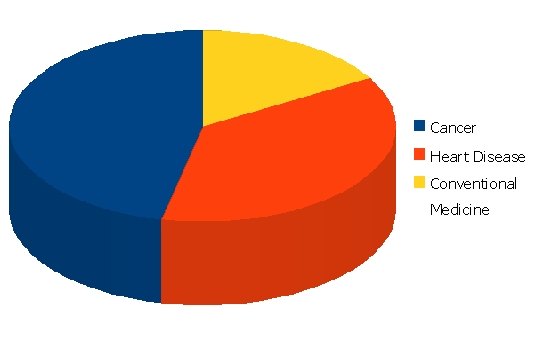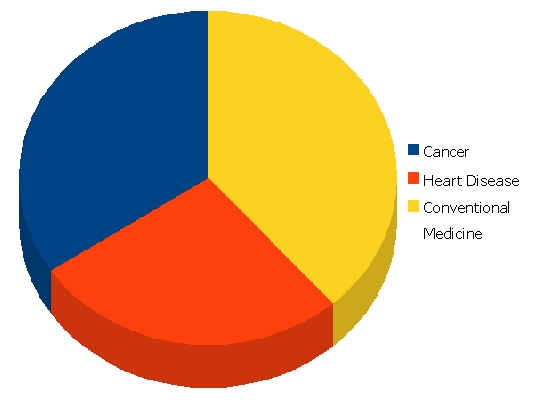Top killers in U.S.
January 14, 2009 at 9:57 pm | Posted in BioMedicine, Modern Research, Science, Social Medicine | 3 CommentsTags: Iatrogenic Disease

Tope three killers in the u.s. as reported in JAMA: 1 700000 2. 553000 3. 250000
(* Note: I made two errors when making my beautiful piechart – I cited 250,000 as the number of iatrogenic deaths, when the actual number is 280,000. I also mistakenly switched two sources for the deaths, ADRs and total injuries. Source below.)
Over a million patients are injured in U.S. hospitals each year, and approximately 280,000 die annually as a result of these injuries. Therefore, the iatrogenic death rate dwarfs the annual automobile accident mortality rate of 45,000 and accounts for more deaths than all other accidents combined.
Bates DW, Cullen DJ, Laird N, Petersen LA, Small SD, Servi D, Laffel G, Sweitzer BJ, SheaBF, Hallisey R, et al. Incidence of adverse drug events and potential adverse drug events. Implications for prevention. ADE Prevention Study Group. JAMA. 1995 Jul 5;274(1):29-34.
When these numbers came out in 1995, Reuters didn’t pick them up. Why? These are shocking numbers.
It’s not the only piece of research that paints this shocking picture either: Gary Null paints a picture far more gruesome – total deaths due to conventional medical interventions and problems picked up in hospitals (such as infections) is 783,936 per year. Then, depending on the numbers for the other two top killers, Heart Disease and Cancer, Conventional medicine takes either the top or second spot.
Let’s look at another pie graph:

Top three killers in the u.s. as reported by G Null
The modern healthcare system is not supposed to do this. This is out of bounds. What now?
References:
Lazarou J, Pomeranz BH, Corey PN, Incidence of Adverse Drug Reactions in Hospitalized Patients, Journal of the American Medical Association (JAMA), Vol. 279. April 15, 1998, pp. 1200-05.
Bates, DW., Drugs and Adverse Drug Reactions: How Worried Should We Be? JAMA, Vol. 279. April 15, 1998, pp. 1216-17.
Leape L, Error in medicine, JAMA 1994;272:1851-7.
Schuster M, McGlynn E, Brook R. How good is the quality of health care in the United States? Milbank Q. 1998;76:517-563.
Starfield B. Evaluating the State Children’s Health Insurance Program: critical considerations. Annu Rev Public Health.
Phillips D, Christenfeld N, Glynn L. Increase in US medication-error deaths between 1983 and 1993. Lancet. 1998;351:643-644.
Leape L. Unnecessary surgery. Annu Rev Public Health. 1992;13:363-383.
Weingart SN, Wilson RM, Gibberd RW, Harrison B. Epidemiology and medical error. BMJ. 2000;320:774-777.
Guyer B, Hoyert D, Martin J, Ventura S, MacDorman M, Strobino D. Annual summary of vital statistics 1998. Pediatrics. 1999;104:1229-1246.
HarHolland E, Degruy F. Drug-Induced Disorders – November 1, 1997 – American Family Physicianrold LR, Field TS,
Gurwitz JH. Knowledge, patterns of care, and outcomes of care for generalists and specialists. J Gen Intern Med. 1999;14:499-511.
World Health Report 2000. Available at: http://www.who.int/whr/2000/en/report.htm. 2000;21:569-585.
3 Comments »
RSS feed for comments on this post. TrackBack URI
Leave a comment Cancel reply
Pages
Archives
Categories
- Acupuncture Anomalous Data Point authority Bias BioMedicine China Chinese Medicine Choice collaboration Controversy CPR Diabetes Diagnosis Dietetics Environment Fear heart disease Herbal Medicine History Hospital Iatrogenic Disease jargon Lei Gong Teng Malnutrition Narcissism Pediatrics perception prednisone Qi RCT Rheumatoid Arthritis Science Skepticism Social Medicine Sugar Tainted Milk Technology Terminology Theory Tongue Diagnosis TwHF Vaccination WHO
Create a free website or blog at WordPress.com.
Entries and comments feeds.

“Gary Null paints a picture far more gruesome”
Gary Null makes things up and then threatens to sue people who criticize him:
http://lee-phillips.org/null/
These pie charts, with no references or context. mean nothing. Would all the patients in the yellow portion of your first chart have survived had they not sought conventional medical care? For how long?
Comment by Lee Phillips— January 16, 2009 #
Hi Lee; thanks for the visit.
Fortunately for me, Gary Null is tangential to my points, although the numbers I reference to him are in turn referenced by him from some of the (excellent) resources I’ve listed. So it’s actually not him, if you follow me.
As for your second question, all I can say is that these fully refereed articles published in leading medical journals used the words “unnecessary deaths” to describe the yellow portions of my beautiful pie graphs. That should answer your question. Your implication that even when conventional medicine causes “unnecessary deaths” that it is still somehow necessary is not in accord with published evidence or standard of practice as delineated in my references.
I suggest that you obtain a copy of the first reference listed (Lazarou, Pomeranz et al) and give it a really thorough read.
While I disagree with you, I welcome your comments, and if you have any other suggestions in reference to my numbers (which are sourced from the reference list I provided) I would be happy to correct them or add information.
Comment by cmtherapies— January 17, 2009 #
Except that you devote a little over half of your article to repeating his assertions.
Actually, it is him, as he routinely misrepresents sources and makes things up.
He’s not able to understand the scientific literature but cites it as a smokescreen.
I found it, although you cited it incorrectly. After reading it I can only conclude that you don’t understand it very well and/or that you are adopting Null’s tactics and simply citing a bunch of articles in order to make people believe that your pre-formed opinions have some kind of scientific backing.
According to the very article you cite, your chart is wrong (and not very useful, as it contains no numbers).
The article does expose adverse drug reactions (in patients in 1994!) as a “serious clinical issue”. Do you think that clinical practice might have evolved a little since then? Maybe as a result of the self-criticism by “conventional medicine” practitioners of which this article is a fine example? Try to absorb this point: this very self-correction, based on science, is what distinguishes “conventional” medicine from “alternative” medicine, and is why the former works and the latter, for the most part, is not effective, as it retains its basis in superstition and wishful thinking. Where is the article in which the “alternative” practitioners discuss and quantify the harm done by their own procedures, so that they can improve?
Finally, what does it mean when a patient dies from an adverse drug reaction, or from any medical intervention? It’s not as if doctors break in to your house and force you to swallow pills. You’re in the hospital being given serious medicine because you’re very sick and might die from your condition if the doctors don’t do something. Adding up all the people who die as a result of an attempt to help them and treating this number as “death from conventional medicine”, and then comparing the number with deaths from heart disease, etc., really makes no sense, unless you (1) subtract lives saved from the number of deaths; (2) exclude people who would have died anyway; (3) learn something about statistics, etc. If that’s not clear, here is an example: suppose you wind up in the hospital, unconscious and with some kind of infection that’s about to kill you. The doctors have to do something, so they give you a powerful antibiotic that you happen to be allergic to; you die from the allergic reaction. In what column do you put the “cause of death”? Did you die from the infection? From whatever you did or whatever other disease you had that led to the infection? From your failure to wear a medical alert necklace listing what you were allergic to? Did “conventional medicine” kill you because they took the course that was most likely to save you, and it failed? Should they have brought in an acupuncturist?
Comment by Lee Phillips— January 29, 2009 #